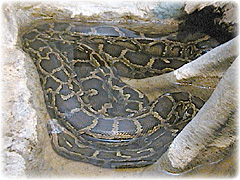| This article has been peer reviewed but is awaiting expert review. If you would like to help with this, please see more information about expert reviewing. |
Introduction
The Burmese python (Python molurus) is a python (family Boidae). Their life span may be 10-15 years.
Morphology
Burmese pythons have an intricate pattern of markings of irregular brown blotches on a yellow background. The Burmese python is widely bred in captivity and comes in a number of mutant forms including albino. They can grow rapidly, attaining 2 metres in length in their first year and perhaps reaching 8 metres.
Free-Living
- Distribution – Burmese pythons are native to India, Ceylon and southeast Asia.
- Habitat – They are often found near water, and are both terrestrial and arboreal.
- Diet – Burmese pythons constrict mammals and birds.
Captivity
- Cage – Terrestrial and arboreal requirements are necessary and the size of cage should be related to the size of snake.
- Temperature - Optimum air temperature during the day is 29°C to 35°C (85°F to 95°F) and at night is 24°C to 27°C (75°F to 80°F). A temperature gradient should be provided so that the snake can move to slightly cooler or warmer temperatures.
- Humidity – A humidity of approximately 60% is preferred.
- Diet – A variety of prey can be fed and includes mice, rats, rabbits, chickens, and guinea pigs. Feed once to twice every 10 days.
- Reproduction – Burmese pythons are relatively easy to breed in captivity. They are oviparous and
usually lay between 30-50 eggs (up to 100 recorded). The female incubates the eggs by curling around them and "twitching" her muscles. The young are 45 to 60 cm at birth.
- Veterinary considerations - Common medical problems include diseases associated with low cage
temperatures such as respiratory infections and necrotic stomatitis, anorexia and obesity.
Literature Search
Use these links to find recent scientific publications via CAB Abstracts (log in required unless accessing from a subscribing organisation).
Burmese Python (Python molurus) publications

